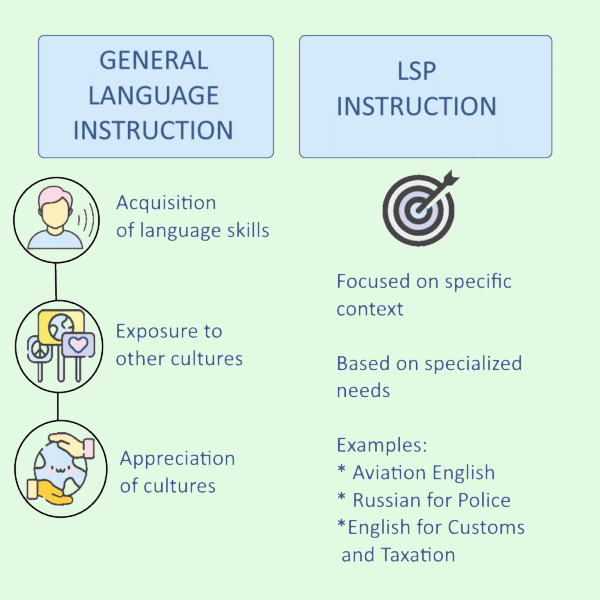Language for Specific Purposes (LSP) is a widely used approach in second and foreign language instruction, designed to meet the immediate and highly specific needs of learners who require the language as a functional tool for their education, training, or profession (Gollin-Kies et al., 2015; Garzone et al., 2016; Riordan, 2018).
The following figure compares General Language Instruction and Language for Specific Purposes, highlighting their key differences:

The table below compares Language for Specific Purposes (LSP), Content and Language Integrated Learning (CLIL), and English as a Medium of Instruction (EMI), focusing on teacher roles, collaboration, feedback, and use of authentic materials.
| LSP | CLIL | EMI |
|---|---|---|
| Language for specific purposes | Content and language integrated learning the vocabulary is used | English as a medium of instruction |
| Language teacher provides the environment, context of where and how the vocabulary is used | CLIL teacher provides the environment, context of where and how the vocabulary is used | EMI teacher teaches a subject through the target language. EMI lesson is a regular lesson with emphasis on the subject not language |
| Content teacher may be involved in the preparation | Content teacher is involved in the preparation | Lesson is prepared by a content teacher, language teacher is not involved (language teacher may help the content teacher prepare for the course) |
| All activities carried out by the language teacher only | Content teacher can do CLIL-tasks; language teacher provides language; teaching = cooperation of language teacher and subject teacher | All activities carried out by the content teacher only |
| Only language teacher | Language methodology support (from language teacher to content teacher) | No language methodology |
| Feedback mainly in the target language (dependent on the students’ language level) | Feedback can be in both languages | No or little feedback on language (feedback on concepts and vocabulary, not grammar) |
| Ready-made textbooks and the teacher’s own handouts (as authentic as possible) | Authentic material (environment); 95% of content and 5% of language-assessment | Authentic material (no or little emphasis on language) |
Steps in designing an LSP course
Brown (1995) outlines a six-step model for curriculum development, which serves as a foundational framework for LSP course design:
- Needs analysis – identifying learners’ specific linguistic requirements within their professional or academic context.
- Goals and objectives – establishing clear learning outcomes based on the identified needs.
- Assessment – designing evaluation methods to measure learner progress and effectiveness of instruction.
- Materials selection and development – choosing or creating appropriate teaching materials tailored to specialized language use.
- Teaching – implementing effective instructional strategies to support skill acquisition in specific contexts.
- Program evaluation – continuously assessing and refining the curriculum based on learner feedback and evolving needs.
References for further reading
- Brown, J.D. 1995. The Elements of Language Curriculum: A Systematic Approach to Program Development. Boston, MA: Heinle & Heinle.
- Gollin-Kies, Sandra, Hall, David R. & Moore, Stephen H. 2015. Language for Specific Purposes.
- Garzone, Giuliana Elena, Heaney, Dermot & Riboni, Giorgia. 2016. Language for Specific Purposes: Research and Translation across Cultures and Media.
- Riordan, Emma. 2018. Language for Specific Purposes: Theory and Research.
© All Rights Reserved.
